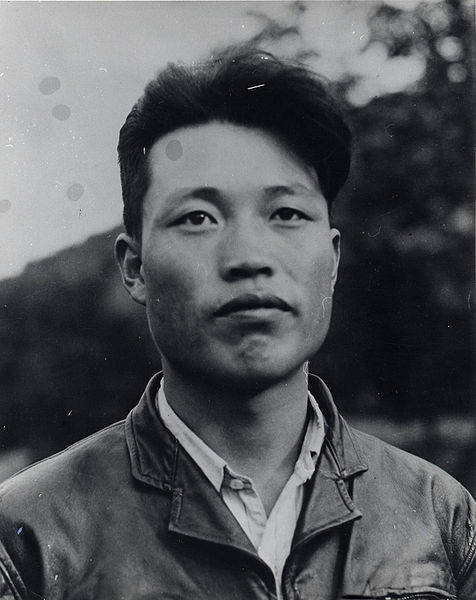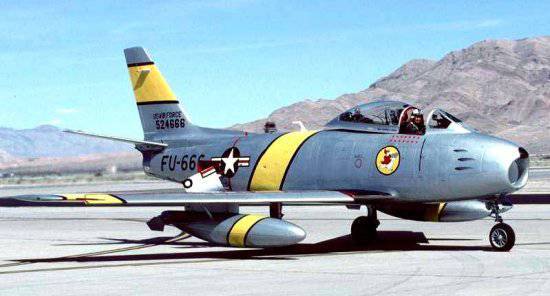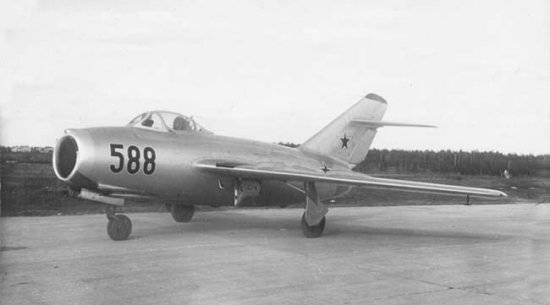How our Saabs in Korea stole
The beginning of the fifties of the twentieth century was marked by the most ambitious and bloody conflict after the Second World War, the war in Korea, between the communist North and the pro-American South, in which the interests of the two superpowers of the USSR and the USA were stung. In this war, which was considered a local conflict for a long time, both the American troops under the auspices of the UN and the Soviet military personnel, operating in an atmosphere of strict secrecy, took part. In combat operations against the US Army, represented by all branches of the armed forces, our anti-aircraft gunners and pilots took an active part.
By the end of 1950, American pilots were able to almost completely destroy the North Korean Aviation and seize undivided power in the "Korean" sky. But this domination lasted until the first meeting of the US Air Force with Soviet MiG-15 aircraft, under the control of the best aces of the USSR Air Force. In the very first battles, our pilots shot down several American bombers and fighters without losing a single one and sowing almost panic in the ranks of the US Air Force. US Army Commander MacArthur was forced to report to the Chiefs of Staff: the morale of the pilots was falling, flights did not bring the previous effect, the enemy’s military equipment was significantly superior to the US, even Sabers were unable to cope with it (F-86).
Mig-15 exceeded its main rival in just two indicators of climb and armament: two 23-mm caliber cannons and one 37-mm with high rate of fire, the shells of which pierced any armor. For the rest of the characteristics of these fighters were equal.
In the spring of 1951, having suffered significant losses, 12 bombers and 4 fighters, when attacking the railway bridge across the Yaludzyan river and without knocking down a single Soviet plane, even using the latest F-86 in battle, the Americans realized that they were opposed by a modern Soviet fighter. It was decided to get an air car at any cost.
The US military developed a plan to capture the MiG-15 and began to diligently implement it. But they did not take into account a very important factor, the skill of the Soviet aces pilots, many of whom went through the second world war and had no small combat experience, all attempts by US pilots to seize the MiG failed successfully.
Quickly realizing that they could not “steal” MiG in battle, the Americans decided to “buy” it. US planes began to scatter flyers, in which they promised to pay anyone who delivered them a MiG first 100 000 dollars, and then 1 000 000, but this plan was not crowned with success.
Meanwhile, in Moscow, in the main headquarters of the Soviet Air Force, in retaliation for the actions of the Americans, a plan was developed to land the “Sabra”. For this purpose, a group of pilots headed by Lieutenant-General of Aviation, Hero of the Soviet Union Alexei Blagoveshchensky, was seconded to Korea. Upon arrival, Blagoveshchensky gathered the commanders and announced: to provide us with all the information about the air situation — we will take Saber. What led the pilots to easy confusion: you to start though, would hit, and only then land. What was followed by a cheerful, optimistic answer: we ourselves with a mustache, you are told to supply information, then supply.
And yet, after the first attempt to capture the Saber, which ended in complete failure, the group from Moscow had to listen to the opinion of the pilots. But the second attempt ended in vain, during these operations one MiG was shot down, two were seriously damaged and one turned over during landing, taking with it the life of one of the members of the Moscow group of Colonel Dzyubenko. After that, Blagoveshchensk with his group departed for Moscow.
The capture of the Sabra took place later in September of the 1951 of the year. One of our pilots, Colonel Yevgeny Pepelyaev, the hero of the Soviet Union - on account of which 19 shot down American planes participating in the battle knocked out one of the “Sabre”, damaging his catapult and engine. The American fighter pilot, saving his life, planned and sat on the pebbles near the sea, just at the right moment for him to ebb. The pilot was quickly picked up by the rescue service, and the plane remained ...
Then the Americans tried to bomb the lost fighter, but the sea tide that had begun reliably hid the plane, and then night fell. Our military did not fail to take advantage of the chance and in the course of the night they dragged the plane to a fairly decent distance, disguised it as a haystack, where he stood all the next day. Further, the next night, for convenience of transportation, the wings were cut from the fighter, it was successfully delivered to our airfield, disassembled, packed and sent to Moscow. It was the first trophy Saber.
Then there was another one, the pilot of which was taken prisoner, also successfully delivered to the airfield in Andund packed and sent to Moscow. And one more, modified with a radar, which the Americans managed to bomb, nevertheless, but most likely not completely, as soon as the radars on fighters appeared in our country.
It only remains to add that the brave American warriors could not get a captured MiG in battle, but they managed to "buy" a fighter, and then only in the 1953 year.

But Gym Sok is a lieutenant of the DPRK Air Force, a participant in the Korean War, who escaped to South Korea. 21 September 1953, after the end of hostilities, he hijacked the MiG-15 aircraft, landed at Gimpo airport and said that he was tired of living with “red liars”. Because But hijacked the plane, he received 100 000 dollars instead of the promised million, but he himself claims that this was not the reason for his escape.
(Wikipedia, the free encyclopedia).
- http://topwar.ru"rel =" nofollow ">http://topwar.ru


Information